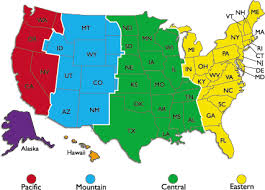Daylight Saving Time (United States) 2016 begins at 2:00 AM on Sunday, March 13
March 13, 1884 “Standard Time” takes effect for the railroads, with four time zones across the United States. Standard time will not be official in the U.S. until 1918.
So how did this all come about by actions of the United States railroads? Would have thought it was a law passed by both houses of Congress and signed by the President? Would have thought it was carefully considered by the Executive branch: Departments of Homeland Security and the Department of Health, Education and Welfare. But neither of them were around in 1884.
The United States was divided into four time zones on November 18, 1883, and jurisdiction for the zones was given to the Interstate Commerce Commission (ICC). All places keep the same time within each time zone. The zones in the United States were intended to represent the mean times of four different meridians (not including daylight saving time):
- Eastern Standard Time (EST).
- Central Standard Time (CST).
- Mountain Standard Time (MST).
- Pacific Standard Time (PST).
A congressional act transferred the ICC’s responsibilities on time zone boundaries to the US Department of Transportation (DOT) in 1967. Today, the United States and its territories observe standard time within nine time zones. The United States’ time zones are defined in the U.S. Code, Title 15, Chapter 6, Subchapter IX – Standard Time. The US law on zones for standard time also states the term Coordinated Universal Time (UTC), referring to it as the time scale maintained through the General Conference of Weights and Measures and interpreted or modified for the United States by the Secretary of Commerce in coordination with the Secretary of the Navy.
DOT is also responsible for the rules governing DST (not all parts of the United States observe daylight saving time). Daylight saving time in many parts of the United States is in line with section 110 of the United States’ Energy Policy Act of 2005, which states that daylight saving time would begin on the second Sunday of March and it would end on first Sunday of November. The Energy Policy Act of 2005 does not alter the rights of the states and territories that choose not to observe daylight saving time.
States and territories in the United States that do not observe daylight saving time include: Hawaii, American Samoa, Guam, Puerto Rico, the Virgin Islands and most of Arizona except the Navajo Nation Community. Some parts of Indiana previously did not observe daylight saving time but the state is now united in observing the schedule despite being split into different time zones.



Reblogged this on KCJones.
LikeLike